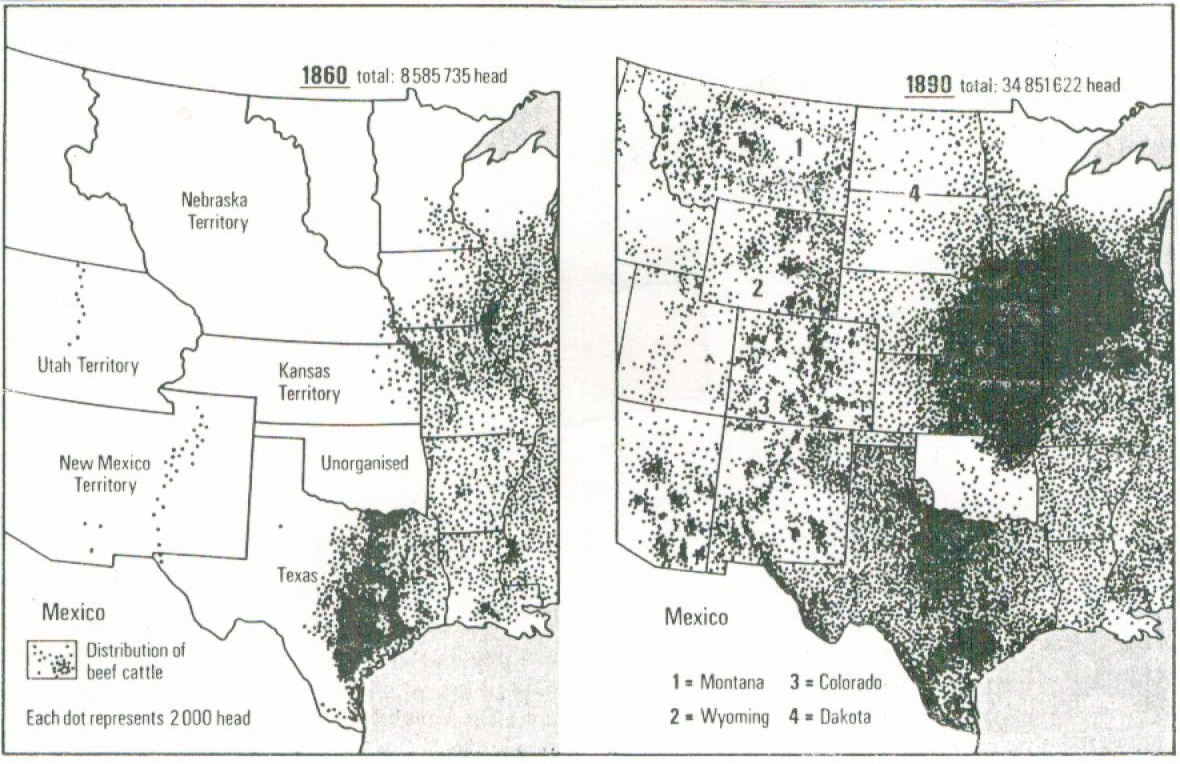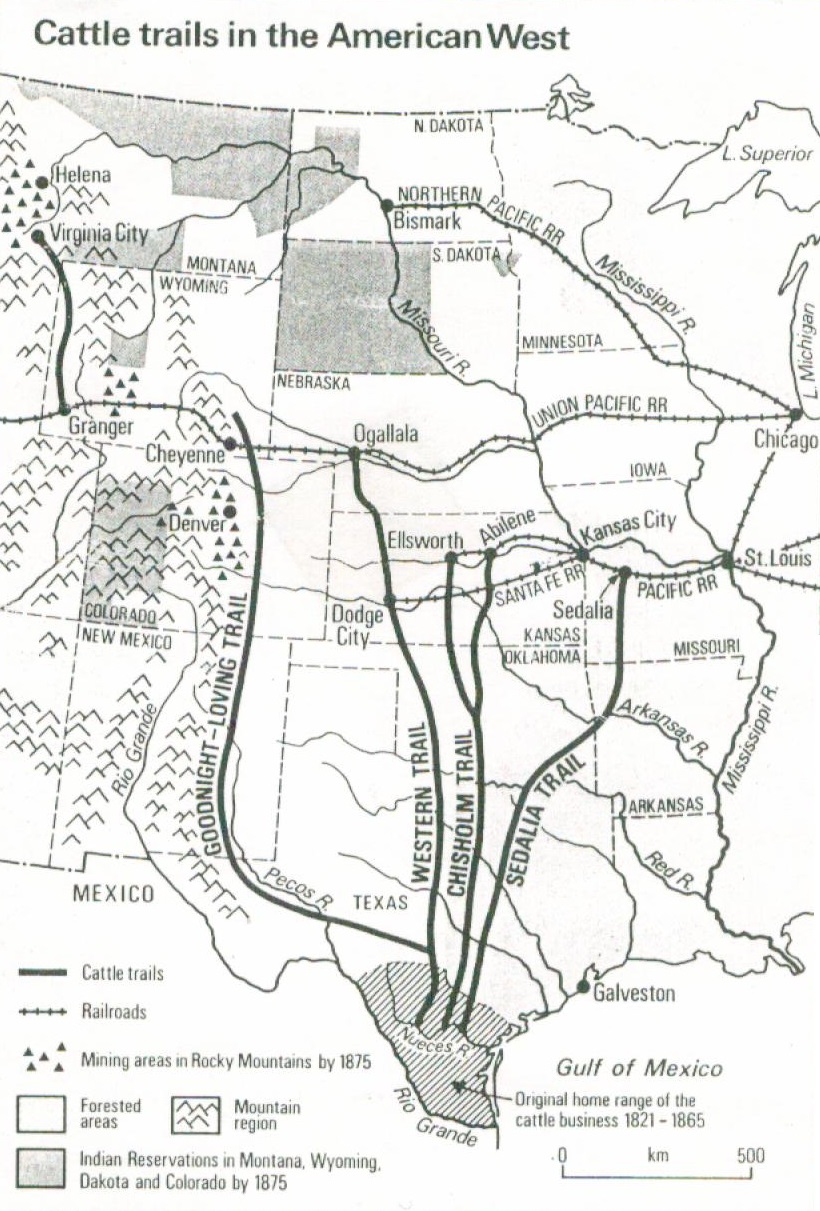|

These two maps show how quickly the cattle-ranching industry grew after 1860,
Beginnings of the Cattle Kingdom
- First cattle owners and cowboys were Spaniard vacqueros.
- In Texas cattle roamed free - branding used to identify ownership.
- 1836: Texas rebellion against Mexico – established own republic. Mexicans abandoned land and cattle.
Texans took over their ranches, but not as serious businesses.
- 1846 – the first long drive: Edward Piper drove 1,000 Texas cattle to Ohio to sell.
- 1850s: although a few ranchers drove their cattle north, they were not
welcome becausethe Longhorn cattle carried a tick which transmitted 'Texas
fever'; Missouri and Kansas quarantined their land against southern cattle.
-
1861-65: Teaxas cattle wandered free during Civil War and bred, so soldiers returning home
found large numbers of Longhorn cattle roaming free and unbranded.
Beginning of the Long Drives

- Word spread that beef was in short supply in the northern towns such as Chicago.
-
Charles Goodnight
and others began to drive herds north to the markets.
-
Goodnight and Oliver Loving opened up the Goodnight-Loving Trail to Colorado
(1866).
Railroads and Cowtowns
- Railways were the key factor – could carry cattle further, producing
more profit.
The Kansas Pacific Railroad was built to Sedalia in 1867. In
1870-1900, 170,000 miles of railroad track was laid, reducing the need for long cattle drives.
- Abilene – on the
Kansas Pacific Railroad and at the end of the Chisholm Trail – became was the first cow town when
Joseph McCoy
built stockyards there in 1867. Cattle were put on trains and transported to Chicago. The cattle men could trade them safely. Other towns (eg.
Ellsworth, Ogallala) were set up.
Ranching on the Northern Plains
- A loop-hole in the law stated that, if a rancher owned any land in a valley, he had the right to graze his cattle over all of it. Thus, by buying a few acres, a rancher gained the right to use all of it – this was nicknamed the 'Crazy Quilt'.
- In 1870 Goodnight founded
the Rock Canon ranch in Colorado, showing that ranching on the Plains could be successful; in 1876 he founded the JA Ranch in the Texas Panhandle – others followed.
-
John Iliff - 'Cattle King of the Northern Plains' – bought Longhorns from homesteaders and drover, and fattened them up on his land in Colorado, using the railway to open up markets. By the 1870s he owned 15,000 acres of land, and controlled (through the Crazy Quilt) 600,000 acres of the open range.
- In 1880, Goodnight founded the Panhandle Stock Association to hunt down rustlers – eg it was a PSA detective who killed Billy the Kid in 1881.

This map shows the land owned by the Swan Cattle
Company in Wyoming, showing the blocks of land owned by the Company which
enabled them to control the entire range.
Cowboys
Cattlemen had huge herds that needed watching, then driving
hundreds of mile – needed cowboys with skills:

- Jobs:
- Winter: little to do around ranch - many cowboys unemployed, but a few lived
in line camps to prevent cattle drifting onto the open plain.
- Spring: 'bog-riding' to haul out 'mired' cows (stuck in mud)/ round-up (collect all cattle of same brand).
- Summer: trail drives of cattle to market.
- Clothes worn for comfort and convenience:
- hat: protection from sun, wind, rain/ useful as pillow/ give horse a drink.
- bandana: used as mask against dust.
- chaps: protect legs in fall or from chafing.
- boots and spurs: heeled boots are more comfortable for riding.
- saddle: the 'cowboy's throne'; very valuable because his livelihood.
- Dangers and hardships:
thieves; Indigenous raiding parties; angry homesteaders; floods; storms;
prairie fires; stampedes; long hours – many deaths, especially on the long
drives.
- Life similar to Indigenous people in many ways:
- Depended on Great Plains.
- moved around (though driving, , not following herds).
- cared for cattle, eg bog riding/ line camps (cf dog soldiers during the hunt).
- food and clothing based on cattle (cf reliance for the buffalo).
- round-up was a collective event – all co-operated (cf buffalo hunt).
Beef Bonanza
The hey-day of the cowboys and cattlemen was 1880-1885 because:
- Indigenous Peoples on reservations needed beef.
- More railways had been built, with refrigerated carriages.
-
High prices for beef in the east.
Note especially James Brisbin's book about Goodnight's success:
Beef Bonanza on the Plains, or How to Get Rich Quick (1881) – encouraged
others to go into cattle ranching.
End of the Open Range
- By 1885 ranges were overstocked – too many cattle overgrazed the range, and
flooded the market, depressing
prices.
- In 1883 a drought killed the Prairie grass, making the verstocking worse.
- 1886-1887 was a very bad winter – herds could not be fed and froze to death.
Ranchers realized they would have to fence off land and grow winter fodder.
- Barbed wire – provided cheap fencing for homesteaders → ‘range wars’ with Homesteaders over fenced land and cattle-rustling → end of the open range.
- Windpump gives water (no need for open range)
→ end to cowboys' life
- The Wyoming Stock Growers Association was formed to organize and defend the cattle industry → Johnson County War.
|
Going Deeper
The following links will help you widen your knowledge:
Good introduction
- Chorus Trust
A timeline (pdf)
'Cowboys and Indians': Similarities and Differences
The Johnson County War - the story in Sources
The Johnson County War - useful teachit exercise
Case Study
Cattle-ranching in Lincoln County, Nebraska
Law & Order in Abilene
 Cattle Ranching - from Hodder Cattle Ranching - from Hodder
 Why did cattle ranching grow so quickly on the Plains? Why did cattle ranching grow so quickly on the Plains?
Activity:
Ranching Mismatches
YouTube and video
How did the cattle business change 1850 to 1880 - Pete Jackson
Rise of the Cattle Industry - Mr Cloke
Decline of the Cattle Industry
- Mr Cloke
Changing Life of the Cowboys - Mr Cloke
Ranchers versus Homesteaders - Mr Cloke
The Johnson County War 1892 - Mr Cloke
Where did the cowboys come from? - BBC
Life of the cowboys - BBC
Consider:
1. Using the links on the Johnson County War in the
Going Deeper section, plan a narrative analysis essay on the key
events.
2. Using the timeline in the Going Deeper section,
analyse the listed events to create separate timelines for the key
moments in:
•
the rise of the cattle-ranching industry;
• the
decline of the cattle-ranching industry.
- Edexcel-style Questions
1. Explain two consequences of:
• the railroads for the development of cattle-ranching on the Plains
• the development of refrigerated railcars at the end of the 1870s.
2. Write a narrative account analysing:
•
the growth of cattle ranching,
• the key events of the range wars between homesteaders
and cattlemen
• the ways in which the cattle industry changed
after c1875.
3. Explain the importance of:
• Charles Goodnight in the development of cattle ranching
•
John Iliff for ranching on the Plains.
• the work of
the cowboy in the growth of cattle ranching
• cow towns such
as Abilene for the development of cattle ranching
• the Johnson County War
•
the winter of 1886-87 in the decline of the cattle ranching industry.
- OCR-style Questions
1b. Name one
cattle-rancher who helped develop the long drives.
1c. Give one example of a cow town that grew in the 1860s and 1870s.
2. Write a clear and organised summary that analyses the cattle business between 1861 and 1890.
3. Why did cattle-ranching thrive on the Plains between 1861
and 1890? Explain your answer.
4. 'The influx of homesteaders after 1862 destroyed cattle
ranching'. How far do you agree?
|



